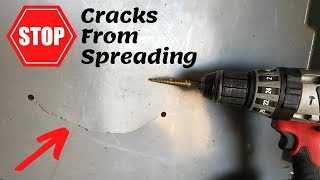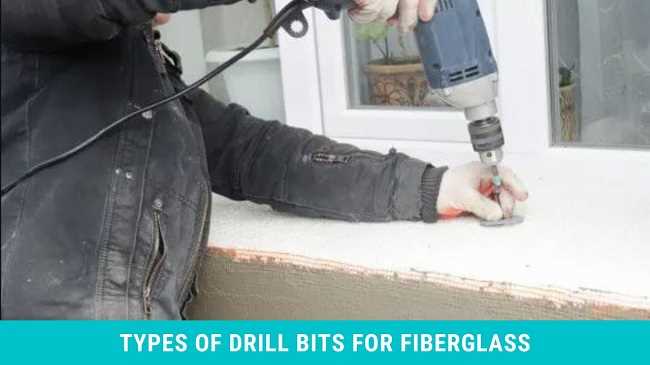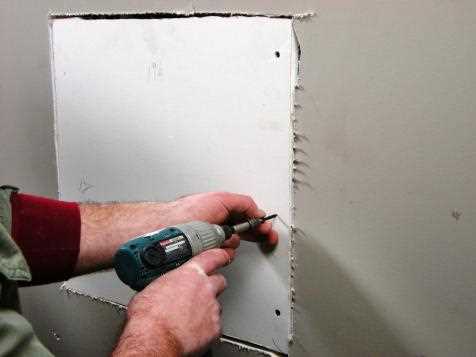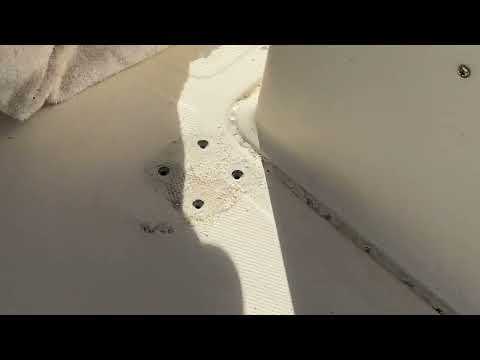How to Drill Fiberglass Without Cracking: Essential Tips and Techniques

Drilling into fiberglass can be a daunting task, as the material has a tendency to crack easily if not approached correctly. However, with a few essential tips and techniques, you can successfully drill into fiberglass without any unsightly cracks or damage.
1. Choose the right drill bit: When drilling into fiberglass, it’s crucial to use a drill bit specifically designed for the material. A carbide or diamond-coated drill bit is recommended, as they are durable and minimize the risk of cracking.
2. Mark your drilling points: Before drilling, mark the exact spots where you want to create holes. Use a marker or tape to ensure accuracy, as this will help prevent any unnecessary damage to the fiberglass surface.
3. Apply masking tape: To further protect the fiberglass from cracking, apply a strip of masking tape over the drilling points. This will provide an added layer of support and help prevent any potential cracks.
“Drilling into fiberglass requires patience and a steady hand. Take your time and apply consistent pressure.”
4. Set the drill to a low speed: When drilling into fiberglass, it’s important to set your drill to a low speed setting. This will help prevent any excessive heat or friction that can cause the fiberglass to crack.
5. Use light pressure: Apply gentle and even pressure when drilling into fiberglass. Avoid using excess force, as this can lead to cracks. Slow and steady wins the race when drilling into this delicate material.
6. Take breaks: If you’re working on a larger project that requires multiple holes, take breaks between drilling. This will allow the fiberglass to cool down and reduce the risk of cracking due to heat build-up.
By following these essential tips and techniques, you can successfully drill into fiberglass without any cracks or damage. Remember to take your time, use the right tools, and apply gentle pressure. With practice, you’ll become proficient in drilling into fiberglass and achieve professional results.
Step-by-Step Guide to Drilling Fiberglass Properly
1. Gather the necessary materials and tools
Before you start drilling fiberglass, make sure you have all the materials and tools you’ll need:
- Safety glasses
- Mask or respirator
- Drill
- Drill bits specifically designed for drilling fiberglass
- Clamp or vise
- Marker or tape measure
2. Determine the exact location for the hole
Use a marker or tape measure to mark the exact location where you want to drill the hole in the fiberglass. Double-check the measurements to ensure accuracy.
3. Secure the fiberglass
To prevent cracking or flexing of the fiberglass, secure it firmly using a clamp or vise. This will provide stability and support during the drilling process.
4. Put on safety gear
Before you start drilling, put on your safety glasses and a mask or respirator to protect your eyes and lungs from any dust or debris that may be generated.
5. Choose the appropriate drill bit

Select a drill bit specifically designed for drilling fiberglass. These bits generally have a sharper point and are made of materials like carbide or diamond, which are more effective at cutting through fiberglass without causing damage.
6. Begin drilling
Position the drill bit against the marked spot on the fiberglass and apply gentle pressure. Start drilling at a slow speed to create a pilot hole, then gradually increase the speed as you continue drilling.
7. Use a lubricant
If you encounter resistance or the fiberglass starts to crack, stop drilling and apply a lubricant like cutting oil or water to reduce friction and prevent overheating. This will help extend the life of your drill bit and minimize damage to the fiberglass.
8. Clean up the drilled hole
Once you have drilled through the fiberglass, remove the drill bit and clean up any loose fiberglass debris or dust. You can use a vacuum or compressed air to clear away any remaining particles.
9. Inspect the drilled hole
After drilling, inspect the hole to ensure it is smooth and free of any cracks or damage. If there are any rough edges, use sandpaper or a fiberglass repair kit to smooth and seal the hole.
10. Secure any fasteners
If you are drilling the fiberglass to install fasteners, make sure to secure them properly using the appropriate hardware. This will ensure that they are securely in place and won’t cause any damage to the fiberglass.
Following these steps will help you drill fiberglass properly and minimize the risk of cracking or damaging the material. Remember to always wear protective gear and take your time to ensure accuracy and safety.
Choosing the Right Drill Bit for Fiberglass
When drilling into fiberglass, it’s important to use the right type of drill bit to prevent cracking and damage. Here, we will discuss the different types of drill bits that are suitable for drilling fiberglass.
1. Carbide-Tipped Drill Bits
- Carbide-tipped drill bits are a popular choice for drilling fiberglass due to their durability and ability to withstand high temperatures.
- These drill bits have a carbide tip that is extremely hard and can easily cut through fiberglass without causing cracks or chips.
- Carbide-tipped drill bits are more expensive than regular drill bits, but they are worth the investment if you plan on drilling fiberglass regularly.
2. Diamond-Coated Drill Bits
- Diamond-coated drill bits are another excellent option for drilling fiberglass.
- These drill bits have a thin coating of diamond particles on the tip, which makes them extremely sharp and able to cut through fiberglass smoothly.
- Since fiberglass is a relatively soft material, diamond-coated drill bits can last longer and provide better performance compared to other types of drill bits.
3. High-Speed Steel (HSS) Drill Bits
- High-speed steel drill bits are commonly used for drilling various materials, including fiberglass.
- Although not as hard or durable as carbide-tipped or diamond-coated drill bits, HSS drill bits can still effectively drill through fiberglass without causing cracks.
- It’s important to use a sharp and high-quality HSS drill bit to prevent excessive heat build-up, which can cause the fiberglass to crack.
4. Brad-Point Drill Bits
- Brad-point drill bits are another suitable option for drilling fiberglass.
- These drill bits have a sharp, pointed tip that helps prevent the bit from wandering or slipping on the smooth surface of fiberglass.
- Brad-point drill bits also have flutes that help to remove debris as you drill, reducing the risk of clogging and overheating.
When choosing a drill bit for fiberglass, it’s important to consider the size and type of hole you need to drill. It’s recommended to start with a smaller pilot hole and gradually increase the size to minimize the risk of cracking. Always use a drill bit that is sharp and in good condition to ensure clean and accurate holes in fiberglass.
Preparing the Fiberglass Surface for Drilling
Before you start drilling into fiberglass, it’s important to properly prepare the surface to minimize the risk of cracking. Follow these essential steps to ensure a successful drilling process:
- Mark the drilling location: Start by identifying the exact spot where you want to drill the hole. Use a marker or masking tape to mark the spot on the fiberglass surface. This will help you maintain accuracy and prevent any unnecessary damage.
- Gather the necessary tools: Make sure you have all the required tools and equipment before you begin. You will need a power drill, the appropriate drill bit for fiberglass, safety goggles, a dust mask, and a clamp or vice to secure the fiberglass piece.
- Secure the fiberglass piece: To prevent the fiberglass from moving or vibrating during the drilling process, it’s important to secure it using a clamp or vice. This will ensure stability and reduce the risk of cracking or splintering.
- Protect yourself: Fiberglass dust can be harmful if inhaled, so it’s crucial to protect yourself by wearing safety goggles and a dust mask. These items will shield your eyes and respiratory system from any potential harm.
- Select the right drill bit: When drilling fiberglass, it’s essential to use a drill bit specifically designed for this material. A carbide-tipped or diamond-coated tip is recommended for best results. These types of drill bits will minimize the risk of cracking or splintering the fiberglass surface.
- Apply gentle pressure: Start drilling with gentle, steady pressure. Avoid applying excessive force as it can cause the fiberglass to crack. Let the drill bit do the work and allow it to gradually cut through the material.
- Use a low drilling speed: Set your power drill to a low speed setting when drilling fiberglass. A higher speed can generate excess heat, leading to melting or cracking of the material. A slower speed will help maintain control and prevent any damage.
- Keep the surface lubricated: To reduce friction and heat buildup, it’s advisable to keep the drilling area lubricated. You can use a spray bottle filled with water or a specialized lubricant for fiberglass. Apply the lubricant periodically while drilling to ensure smooth and hassle-free progress.
- Work in short bursts: Instead of continuously drilling for an extended period, work in short bursts. This will prevent the fiberglass from overheating and minimize the risk of cracking. Take breaks between drilling sessions to allow the fiberglass to cool down.
By following these essential preparation steps, you can ensure a smooth and successful drilling process without cracking or damaging the fiberglass surface.
Marking the Drilling Points on Fiberglass
Before you begin drilling into fiberglass, it is crucial to properly mark the drilling points. This will ensure accuracy and prevent any cracking or damage to the material. Here are some essential tips for marking the drilling points on fiberglass:

- Plan the location: Determine where you want to drill the holes and carefully measure the dimensions. Use a pencil or a removable marker to mark the spots.
- Use masking tape: Applying masking tape over the area where you plan to drill can help protect the fiberglass and reduce the risk of cracking. Mark the drilling points on the tape.
- Center punch: To create a small dent or guide point, use a center punch tool on the marked drilling points. This will provide a starting point for the drill bit and prevent it from slipping.
- Protective layer: Place a piece of scrap wood or plastic underneath the fiberglass to prevent any damage on the opposite side during the drilling process.
- Double-check: Before drilling, double-check the marked points to ensure they are accurate. Adjust or re-mark if necessary.
Following these tips will help you mark the drilling points accurately on fiberglass and minimize the risk of cracking or damage during the drilling process.
Drilling Techniques for Fiberglass without Cracking
When it comes to drilling fiberglass, it is important to follow certain techniques to avoid cracking or damaging the material. Here are some essential tips to help you drill fiberglass successfully:
1. Use the Right Drill Bit
Choosing the right drill bit is crucial for drilling fiberglass without cracking it. A carbide or diamond-coated drill bit is recommended as they are specifically designed for hard and brittle materials like fiberglass. Avoid using regular twist drill bits as they can cause cracking.
2. Mark and Secure the Area
Before drilling, mark the exact location where you want to make the hole. Use a pencil or tape to create a guide for accurate drilling. Additionally, secure the fiberglass material firmly to avoid vibrations that can lead to cracking.
3. Start with a Pilot Hole
Starting with a small pilot hole is a good practice for drilling fiberglass. Use a smaller drill bit to create a guide hole before drilling the actual size hole. This helps in preventing the drill bit from wandering and reduces the risk of cracking.
4. Apply Steady Pressure
When drilling into fiberglass, it is important to apply steady pressure throughout the drilling process. Avoid excessive force or pushing too hard as it can cause cracks. Maintain a consistent speed and pressure to ensure a smooth and clean hole.
5. Use Lubrication
Lubrication can help reduce friction and heat buildup while drilling fiberglass. Use a lubricant like cutting oil or water to keep the drill bit cool and prevent it from overheating. This helps in preventing cracks due to excessive heat.
6. Drill at a Slow Speed
Drilling at a slow speed is recommended for fiberglass to prevent cracking. High speeds can generate excessive heat and cause the material to chip or crack. Set your drill to a lower speed setting and take your time while drilling.
7. Clean the Drill Bit
Periodically clean the drill bit during the drilling process to remove any debris or fiberglass particles that may clog the flutes. This helps maintain the cutting efficiency of the drill bit and reduces the risk of cracking.
8. Take Breaks
If you’re drilling multiple holes or working on a large fiberglass project, take regular breaks to give the drill bit and fiberglass a chance to cool down. This can help prevent overheating and cracking due to prolonged drilling.
By following these drilling techniques, you can successfully drill fiberglass without cracking or damaging the material. Remember to always prioritize safety and wear appropriate protective gear while drilling.
Cooling and Lubricating the Drill Bit
When drilling into fiberglass, it is important to keep the drill bit cool and lubricated. This will help prevent the bit from overheating and potentially cracking the fiberglass. Here are some tips for cooling and lubricating the drill bit:
- Use a cutting fluid: Applying a cutting fluid to the drill bit can help reduce friction and heat. You can find cutting fluid at most hardware stores. Simply apply a small amount to the drill bit before drilling into the fiberglass.
- Use water as a cooling agent: If you don’t have cutting fluid on hand, you can use water as a substitute. Wetting the drill bit periodically while drilling will help keep it cool and prevent it from overheating.
- Take breaks: Give the drill bit a chance to cool down by taking breaks during the drilling process. This is especially important when drilling through thicker fiberglass or when drilling multiple holes.
- Use a slow drilling speed: Using a slow drilling speed can help reduce heat build-up and prevent the drill bit from cracking the fiberglass. Set your drill to a lower speed setting and apply consistent pressure while drilling.
Remember, it is crucial to keep the drill bit cool and lubricated when drilling into fiberglass. By following these tips, you can reduce the risk of cracking the fiberglass and ensure a successful drilling experience.
Cleaning and Finishing Drilled Holes in Fiberglass
After successfully drilling holes in fiberglass, it is important to properly clean and finish the holes to ensure a professional and polished look. Here are some essential tips and techniques for cleaning and finishing drilled holes in fiberglass:
1. Remove any debris
Before proceeding with the finishing process, make sure to remove any debris or dust that may have accumulated in the drilled holes. This can be done by using a small brush or a compressed air canister to blow away any loose particles.
2. Sand the edges
Once the holes are cleaned, it is recommended to sand the edges of the holes to create a smooth finish. Use fine-grit sandpaper and gently sand the edges in a circular motion. Be careful not to apply too much pressure, as this can cause damage to the fiberglass.
3. Use a filler or epoxy resin
If the drilled holes are larger or have any imperfections, it is advisable to use a filler or epoxy resin to fill in the gaps. This will help create a seamless and finished look. Follow the manufacturer’s instructions for the specific filler or epoxy resin being used.
4. Let the filler or epoxy resin dry
After applying the filler or epoxy resin, allow it to dry completely according to the manufacturer’s instructions. This may take several hours or even overnight, so be patient and avoid disturbing the drying process.
5. Sand the filled holes

Once the filler or epoxy resin is dry, sand the filled holes using fine-grit sandpaper. This will help smooth out any roughness and ensure a flush finish with the surrounding fiberglass surface. Again, be gentle and apply light pressure while sanding.
6. Clean and polish the surface
After sanding the filled holes, clean the surface of the fiberglass using a mild detergent or fiberglass cleaner. This will remove any dust or residue left behind from the sanding process.
7. Apply a finishing gel coat (optional)
If desired, you can apply a finishing gel coat to the drilled holes to further enhance their appearance and provide added protection. Follow the manufacturer’s instructions for the specific gel coat being used.
8. Buff and polish the surface (optional)

For a truly professional finish, you can buff and polish the surface of the fiberglass surrounding the drilled holes. This will help to blend the repaired area with the rest of the fiberglass and create a seamless look.
By following these tips and techniques, you can achieve a clean and polished finish when drilling holes in fiberglass. Remember to always work carefully and patiently to avoid any damage to the fiberglass material.
Best Practices for Drilling Fiberglass Safely
1. Wear Protective Gear
Before you begin drilling fiberglass, make sure to wear appropriate protective gear to ensure your safety. This includes safety glasses or goggles to protect your eyes from flying debris, a dust mask or respirator to prevent inhalation of fiberglass particles, and gloves to protect your hands from sharp edges.
2. Choose the Right Drill Bit
When drilling fiberglass, it is important to select the right drill bit for the job. A carbide or diamond-tipped drill bit is recommended for drilling into fiberglass, as it is specifically designed to cut through hard materials like fiberglass without causing cracking or damage.
3. Mark the Position of the Hole

Before drilling, use a marker or tape to clearly mark the position of the hole on the fiberglass surface. This will help ensure accuracy and prevent mistakes or misalignment during the drilling process.
4. Use a Center Punch
Prior to drilling, use a center punch to create a small indentation at the center of your marked hole. This indentation will provide a starting point for the drill bit and help prevent it from wandering or slipping on the smooth fiberglass surface.
5. Start Slowly
When drilling fiberglass, it is important to start drilling at a slow speed to prevent cracking or splintering. Begin by applying gentle pressure and gradually increase the speed as you continue drilling.
6. Use Coolant or Lubricant
Using a coolant or lubricant while drilling can help reduce heat and friction, which can prevent cracking and damage to the fiberglass. Apply a small amount of coolant or lubricant to the drill bit and the surface of the fiberglass before drilling.
7. Control the Drill Depth
To prevent drilling through the fiberglass completely or going too deep, use a stop collar or piece of tape to control the drill depth. This will help ensure that you drill to the desired depth without causing any damage.
8. Clean Up Debris
After drilling, clean up any debris or fiberglass particles left behind. Use a vacuum cleaner or a damp cloth to remove any dust or debris from the drilling area to maintain a clean and safe work environment.
9. Practice Proper Technique
Drilling fiberglass requires a steady hand and controlled pressure. Avoid applying excessive force or pushing too hard on the drill, as this can lead to cracking or splintering. Maintain a stable grip on the drill and let the drill bit do the work.
10. Take Breaks as Needed
If you are drilling multiple holes in fiberglass, it is important to take breaks as needed. This will help prevent overheating of the drill bit and reduce the risk of damaging the fiberglass. Allow the drill bit to cool down before continuing to drill.
Conclusion
By following these best practices, you can safely and effectively drill fiberglass without cracking or damaging the material. Remember to always wear protective gear, select the right drill bit, and use proper technique to achieve the best results.
FAQ:
What is the best drill bit to use for drilling fiberglass?
The best drill bit to use for drilling fiberglass is a carbide or diamond-coated drill bit. These types of drill bits are specifically designed to handle the hardness of fiberglass without cracking or chipping the material.
What are some common mistakes that can lead to cracking when drilling fiberglass?
Some common mistakes that can lead to cracking when drilling fiberglass include using too much pressure, drilling at too high of a speed, and not using the correct type of drill bit. It’s important to take your time and use the proper techniques to avoid damaging the fiberglass.
How do I prevent the drill bit from wandering or slipping when drilling fiberglass?
To prevent the drill bit from wandering or slipping when drilling fiberglass, it’s important to use a center punch to create a small indentation in the area you want to drill. This will provide a starting point for the drill bit and help guide it straight through the fiberglass.
Can I use a regular drill for drilling fiberglass?
Yes, you can use a regular drill for drilling fiberglass. However, it’s important to use the correct type of drill bit and to use the proper techniques to prevent cracking or damaging the fiberglass. Using a carbide or diamond-coated drill bit and drilling at a slow speed with light pressure can help ensure a clean and crack-free hole in the fiberglass.
What should I do if I accidentally crack the fiberglass while drilling?
If you accidentally crack the fiberglass while drilling, you can try to repair it using a fiberglass repair kit. These kits typically include a resin and a hardener that can be used to patch up small cracks or holes in the fiberglass. However, for larger or more extensive damage, it may be best to consult a professional for repairs.
Are there any safety precautions I should take when drilling fiberglass?
Yes, there are some safety precautions you should take when drilling fiberglass. It’s important to wear safety goggles to protect your eyes from any flying debris, as well as gloves to protect your hands. It’s also a good idea to work in a well-ventilated area to avoid inhaling any fiberglass particles.
Can I use a regular drill bit on fiberglass if I don’t have a carbide or diamond-coated one?
If you don’t have a carbide or diamond-coated drill bit, you can try using a regular drill bit. However, it’s important to drill at a slow speed and apply light pressure to reduce the chances of cracking or damaging the fiberglass. Keep in mind that using the correct type of drill bit is the best way to ensure clean and crack-free drilling.
Video:










